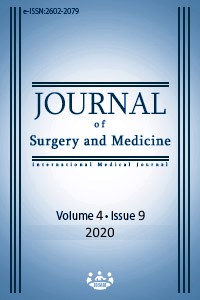The evaluation of epicardial adipose tissue radiodensity according to age
Keywords:
Epicardial adipose tissue, Fatty degeneration, Radiodensity ratioAbstract
Aim: The grading of fatty degeneration by cardiac computerized tomography (CCT) is an important bioradiological marker to discriminate biological characteristics. Epicardial adipose tissue (EAT) degeneration has been accused of causing heart disease. However, the relationship between age and EAT radiodensity is not well known. In this study we examined epicardial adipose tissue radiodensity with CCT. Methods: A total of 147 subjects who underwent contrast-enhanced evaluation of coronary arteries with CCT between Jun 2018-July 2019 due to intermediate probability of coronary artery disease (CAD) were included in this retrospective cohort study. The radiodensities of three epicardial regions (right atrioventricular groove, posterior interventricular groove, and anterior epicardial area) and individual subxiphoid fat radiodensity ratios were obtained. Group comparisons were made according to 10-year-periods (between 10- 80 years of age). Results: We found that epicardial adipose tissue/ subxiphoid fat radiodensity ratio decreased with increasing age. After the 3rd decade, we detected a negative correlation between EAT/subxiphoid fat radiodensity ratio (r=-0.11). The radiodensity ratios of patients between 20-30 and 30-40 years of age in the LCX, RCA and anterior epicardial regions were 1.71 (0.14) and 1.06 (0.40) (P<0.001), 1.71 (0.20) and 1.04 (0.30) (P<0.001), and 1.70 (0.07) and 1.17 (0.42), respectively (P<0.001). Conclusion: EAT radiodensity ratio changes are associated with aging. Increased age is negatively correlated with EAT radiodensity ratio, which is considered fat degeneration. We realized that those changes occurred sharply after the third decade.
Downloads
References
Pracon R, Kruk M, Kepka C, Pregowski J, Opolski MP, Dzielinska Z, et al. Epicardial adipose tissue radiodensity is independently related to coronary atherosclerosis. A multidetector computed tomography study. Circ J. 2011;75(2):391-7.
Franssens BT, Nathoe HM, Visseren FL, van der Graaf Y, Leiner T; SMART Study Group. Relation of Epicardial Adipose Tissue Radiodensity to Coronary Artery Calcium on Cardiac Computed Tomography in Patients at High Risk for Cardiovascular Disease. Am J Cardiol. 2017;119(9):1359-65.
Chekakie MO, Welles CC, Metoyer R, Ibrahim A, Shapira AR, Cytron J, et al. Pericardial fat is independently associated with human atrial fibrillation. J Am Coll Cardiol. 2010;56:784-8.
Wang CP, Hsu HL, Hung WC, Yu TH, Chen YH, Chiu CA, et al. Increased epicardial adipose tissue (EAT) volume in type 2 diabetes mellitus and association with metabolic syndrome and severity of coronary atherosclerosis. Clin Endocrinol (Oxf). 2009;70:876-82.
Eroglu S, Sade LE, Yıldırır A, Demir O, Muderrisoglu H. Association of epicardial adipose tissue thickness by echocardiography and hypertension. Turk Kardiyol Dern Ars. 2013;41(2):115-22.
Hamrahian AH, Ioachimescu AG, Remer EM, Motta-Ramirez G, Bogabathina H, Levin HS, et al. Clinical utility of noncontrast computed tomography attenuation value (Hounsfield units) to differentiate adrenal adenomas/hyperplasias from nonadenomas: Cleveland Clinic experience. J Clin Endocrinol Metab. 2005;90:871-7.
Korobkin M, Brodeur FJ, Yutzy GG, Francis IR, Quint LE, Dunnick NR, et al. Differentiation of adrenal adenomas from nonadenomas using CT attenuation values. Am J Roentgenol. 1996;166:531-6.
Motoyama S, Sarai M, Harigaya H, Anno H, Inoue K, Hara T, et al. Computed tomographic angiography characteristics of atherosclerotic plaques subsequently resulting in acute coronary syndrome. J Am Coll Cardiol. 2009;54:49-57.
Pundziute G, Schuijf JD, Jukema JW, Decramer I, Sarno G, Vanhoenacker PK, et al. Head-to-head comparison of coronary plaque evaluation between multislice computed tomography and intravascular ultrasound radiofrequency data analysis. JACC Cardiovasc Interv. 2008;1:176-82.
Mahnken AH, Bruners P, Bornikoel CM, Kramer N, Guenther RW. Assessment of myocardial edema by computed tomography inmyocardial infarction. JACC Cardiovasc Imaging. 2009;2:1167-74.
Pracon R, Kruk M, Kepka C, Pregowski J, Opolski MP, Dzielinska Z, et al. Epicardial adipose tissue radiodensity is independently related to coronary atherosclerosis. A multidetector computed tomography study. Circ J. 2011;75(2):391-7.
Rabkin SW. Epicardial fat: properties, function and relationship to obesity. Obes Rev. 2007;8:253-61.
Corradi D, Maestri R, Callegari S et al. The ventricular epicardial fat is related to the myocardial mass in normal, ischemic and hypertrophic hearts. Cardiovasc Pathol. 2004;13:313-6.
Lip GY, Nieuwlaat R, Pisters R, Lane DA,Crijns HJ. Refining clinical risk stratification for predicting stroke and thromboembolismin atrial fibrillation using a novel risk factor-based approach: the Euro HeartSurvey on Atrial Fibrillation. Chest. 2010;137:263-72.
Hazzard WR, Ettinger WH Jr. Aging and atherosclerosis: changing considerations in cardiovascular disease prevention as the barrier to immortality is approached in old age. Am J Geriatr Cardiol. 1995;4:16-36.
Downloads
- 471 807
Published
Issue
Section
How to Cite
License
Copyright (c) 2020 Arslan Ocal, Ersin Saricam, Ali Doğan Dursun, M.F.Tolga Soyal, Hakkı Serkan Şahin, Gulcın Sarıyıldız
This work is licensed under a Creative Commons Attribution-NonCommercial-NoDerivatives 4.0 International License.
















